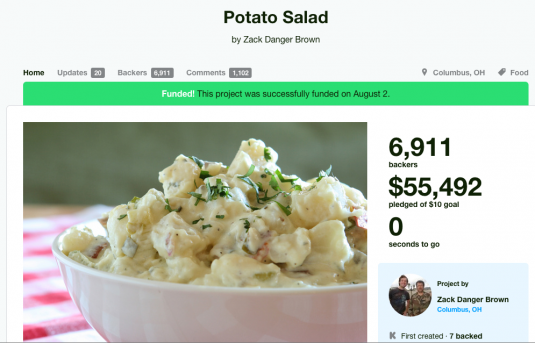Learning from Ridiculous yet Effective Crowdfunding Campaigns
 How much would you pay for a bowl of boiled potatoes, diced onion, relish and some mayonnaise? Maybe two dollars? But, wait, you don’t actually get to taste the potato salad, you just watch a video of someone making the recipe. If you’re not heading to a picnic anytime soon, I’m guessing someone would need to pay YOU to watch the video.
How much would you pay for a bowl of boiled potatoes, diced onion, relish and some mayonnaise? Maybe two dollars? But, wait, you don’t actually get to taste the potato salad, you just watch a video of someone making the recipe. If you’re not heading to a picnic anytime soon, I’m guessing someone would need to pay YOU to watch the video.
However, the Kickstarter that Zack Danger Brown (Danger?) started this summer tells a different story. Nearly 7,000 people came together to support his dream of making potato salad. How much did they think it was worth? $55,492. I remember checking out this Kickstarter when it was around $35,000, and that sounded crazy to me (and a lot of other people). But 50 grand? Ridiculous.
Ridiculous… yet his campaign was certainly effective. He far exceeded his goal, proving that with the right elements anyone can use a crowdfunding campaign to support his or her endeavors.
Campaigns like these can be revolutionary for small businesses who need two things: start-up money and future customer buy-in. In fact, I have a friend who plans to use Kickstarter to help with marketing costs and to create the pre-opening buzz about her new COCOA Dessert Bar in downtown Greenville. So even if you don’t need to raise $20,000 to cover all your costs (and, actually, I’d argue that it’s better that you don’t), you can still use these campaigns to spread the word.
But before you go running off to set up your Kickstarter account, consider incorporating the following elements to maximize your campaign’s success.
Create compelling content
This is where our potato salad friend falls a little short, so I won’t sing his praises for amazing content. Instead, check out this Kickstarter for a coffeehouse that recently opened. Right away, the video, which is obviously a far cry from a home movie, gives viewers an introduction to the idea behind the business, the owners and the reason for the Kickstarter.
Under the video, they’ve included more content through copy and images that further explains what it is they are doing and why they are doing it. So, yes, you need some basic information of the what, where, when, why and how, but it’s a great idea to include some high-quality visuals like videos and images that give your business a face.
Set reachable goals
When Zack Danger Brown started his Kickstarter, his goal was $60—just a tad under that grand total of $55,000. I’ve read that it’s always best to set a goal you are fairly certain you can reach, and then, if you end up reaching it quickly, increase the amount. Unless it’s a truly worthy cause (I’m thinking non-profit projects), your supporters may grow weary in helping you raise tens of thousands of dollars if the pledges are only coming in at $5 donations three times a day. So pick a goal that’s attainable to keep the excitement growing!
Another reason to set attainable goals is to show that you’ve also bought into your idea. You’ve contributed time, effort and resources (or you’re willing to), and you just need a little help to reach that finish line. Setting your total goal as a large sum can easily come off as greedy or lazy, especially if there is no evidence you’ve put forth anything of your own.
Offer real incentives
I recently participated in my very first Kickstarter to build an app version of one of my favorite websites. The main reason I supported the campaign was because I really wanted to be part of a bigger project that I believed in, but the reason I chose the specific donation amount that I did was because of one thing: awesome incentives.
I could donate $10 and call it a day with my name listed on a “thank you” page in the app, or I could bump my amount up to $25 and receive two awesome 8×10 prints, designed by an artist whose work I already loved. Obviously, I chose the slightly higher amount, which meant I could support the cause while getting something pretty neat in return. So, don’t overlook the power of incentives, especially if you’re looking to increase pledge amounts.
Update frequently
I don’t think it’s necessary to update every day, but if your campaign lasts for 30 days, I’d plan on checking in at least three or four times. If you end up reaching or exceeding your goals early on, you will definitely want to update the campaign with a new goal, an idea for any additional funds and a thank you to all your loyal supporters. Your existing supporters are more likely to either give again or urge others to give if they see your campaign as something on-going and active.
Have you seen or supported any awesome crowdfunding campaigns? Better yet, have you created one you can share with us in the comments? I’m thinking of creating one where people pay me to groom my cat, which is WAY harder than making potato salad and also more entertaining. Would you support me?
Enjoyed this post? Read more from Faith!
Faith Jones – Writer & Editor




